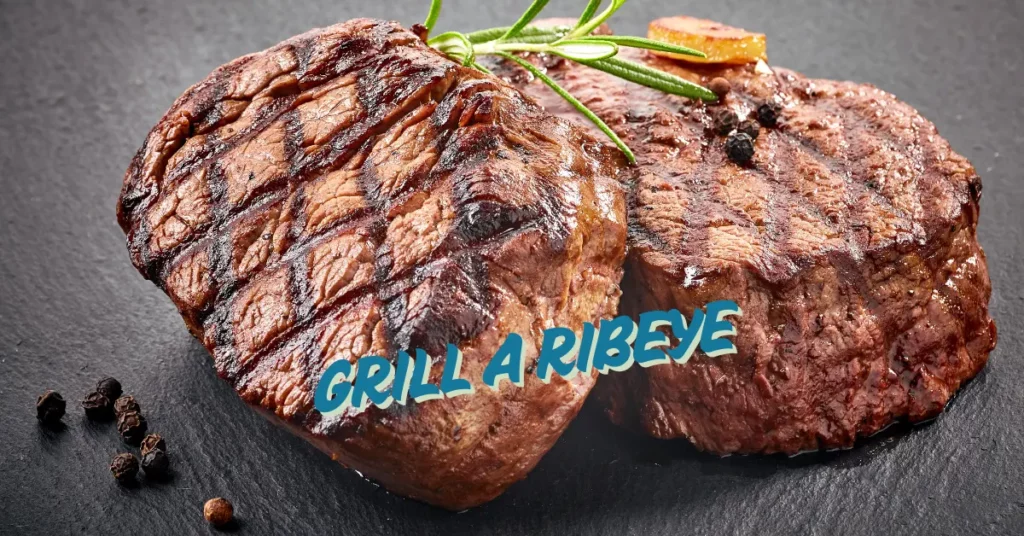This post may contain affiliate links. If you use these links to buy something we may earn a small commission. Thanks.
Grilling a ribeye steak is an art that requires precision, patience, and the right technique to achieve the perfect doneness. Whether you prefer a juicy, rare steak or a well-done cut with a firm texture, knowing how long to grill a ribeye is crucial.
In this guide, we’ll explore the ideal grilling times, key preparation steps, and essential tips to ensure your ribeye turns out flavorful and perfectly cooked every time.
Choosing the Right Ribeye
Before you fire up the grill, selecting the right ribeye is the first step toward a great steak. Here are the factors to consider:
- Bone-in vs. Boneless: Bone-in ribeye generally has more flavor due to the marrow and takes slightly longer to cook than a boneless cut.
- Thickness Matters: The ideal thickness for a ribeye steak is between 1 to 1.5 inches. Thicker cuts require more time and may benefit from a reverse sear technique.
- Marbling: The fat distribution in the steak contributes to tenderness and flavor. Look for a well-marbled ribeye for the best results.
Preparing the Ribeye for Grilling
Proper preparation is key to ensuring your ribeye cooks evenly and retains its juiciness.
- Bring to Room Temperature: Let the steak sit at room temperature for about 30 minutes before grilling. This helps it cook more evenly.
- Seasoning: Simple seasonings like salt and pepper work wonders, but you can also add garlic powder, paprika, or a steak rub for extra flavor.
- Lightly Oil the Steak: Brushing the steak with a small amount of oil helps prevent sticking and enhances the sear.

Preheating the Grill
Achieving the perfect crust on a ribeye starts with preheating the grill to the right temperature.
- Gas Grill: Preheat to 450-500°F for a high-heat sear.
- Charcoal Grill: Light the charcoal and let it turn white-hot before placing the steak on the grates.
- Direct vs. Indirect Heat: Direct heat is best for searing, while indirect heat helps finish cooking thicker cuts without burning.
Grilling Times Based on Doneness
The cooking time for a ribeye steak depends on the level of doneness you desire. Use the following guidelines:
1. Rare (125°F Internal Temperature)
- Grilling Time: 3-4 minutes per side
- Texture: Cool, red center with a soft and tender bite
2. Medium Rare (130-135°F Internal Temperature)
- Grilling Time: 4-5 minutes per side
- Texture: Warm, red center with a juicy, slightly firm bite
3. Medium (140-145°F Internal Temperature)
- Grilling Time: 5-7 minutes per side
- Texture: Pink center with a firmer texture but still juicy
4. Medium Well (150-155°F Internal Temperature)
- Grilling Time: 7-9 minutes per side
- Texture: Slightly pink center, more firm with less juice
5. Well Done (160°F+ Internal Temperature)
- Grilling Time: 9-12 minutes per side
- Texture: No pink, firm throughout, and less moisture
Using a Meat Thermometer
To ensure accuracy, always use a meat thermometer to check the internal temperature rather than relying solely on time. Insert the thermometer into the thickest part of the steak for the most precise reading.
Flipping and Searing Techniques
To achieve a restaurant-quality crust, consider these tips:
- Flip Only Once: Turning the steak too often prevents it from developing a good sear. Flip only once, halfway through cooking.
- Crosshatch Grill Marks: Rotate the steak 45 degrees halfway through each side’s cooking time for a professional-looking presentation.
- Reverse Searing for Thick Steaks: If your ribeye is thicker than 1.5 inches, consider cooking it over indirect heat first, then searing it over direct heat for a crispy crust.
Resting the Ribeye After Grilling
Resting the steak after grilling is just as important as cooking it correctly.
- Why Rest? Resting allows the juices to redistribute throughout the meat, preventing them from running out when you cut into it.
- How Long? Let the ribeye rest for 5-10 minutes before slicing.
- Slicing Tip: Always slice against the grain for maximum tenderness.
Serving Suggestions
A perfectly grilled ribeye deserves the perfect accompaniments. Here are some serving ideas:
Side Dishes
- Grilled asparagus or Brussels sprouts
- Garlic mashed potatoes
- Baked sweet potatoes
- Creamed spinach
- Mac and cheese
Sauces & Toppings
- Garlic herb butter
- Chimichurri sauce
- Blue cheese crumbles
- Mushroom and onion sauté
Beverage Pairings
- Wine: A bold Cabernet Sauvignon or Malbec pairs well with ribeye.
- Beer: A hoppy IPA or dark stout complements the steak’s rich flavors.
Common Mistakes to Avoid
Even experienced grillers make mistakes. Here’s what to avoid:
- Overcooking: Always use a meat thermometer to avoid drying out your steak.
- Skipping the Resting Step: Cutting too soon causes juices to escape, making the steak dry.
- Not Preheating the Grill Properly: A cold grill prevents the steak from searing correctly.
- Using Too Much Seasoning or Marinade: Overpowering the natural beef flavor can take away from the steak’s richness.
Conclusion
Grilling a ribeye to perfection is all about mastering the balance between heat, timing, and technique. By following the guidelines in this guide, you can confidently grill a ribeye to your preferred doneness while preserving its flavor and juiciness.
So fire up the grill, grab your favorite seasoning, and enjoy a perfectly cooked ribeye steak at home.
